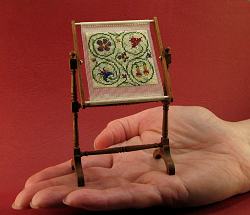How to make a dollhouse needlework stand
ONLINE MINIATURE NEEDLEPOINT EMBROIDERY TUTORIALS
These tutorials were originally written to help people who had bought my dollhouse needlepoint kits – they show you how to do the stitching and assemble each type of kit. In November 2024 I retired, so these pages are now a ‘legacy archive’ only. I NO LONGER SELL THESE KITS, so please do not contact me asking where you can buy them! I plan to keep these tutorials available until at least the end of 2026, so that people who bought kits but haven’t made them up yet have a while to use the tutorials to complete their kits 🙂
A lovely needlework stand is almost essential in any doll’s house belonging to someone who loves to stitch! Surely, your dolls will love to stitch, too?!

The needlework stands measure two and three eighths of an inch wide by three and three quarters high (6cm by 9cm), and are made from finely-turned, high quality mahogany.
The designs are to be stitched in tent stitch (similar to half cross stitch) on 40 count silk gauze, using one strand of Anchor stranded cotton.

The kits contain an easy-to-assemble mahogany needlework stand kit (including white wood poles and brass pins to hold the frame on the stand), along with all you need to stitch the design – a generous piece of 40 count silk gauze fabric, ample Anchor stranded cotton thread, a fine needle, colour block chart (the design is not printed on the fabric) and detailed instructions.
To start with, mount the silk gauze in a card mount to keep it taut (see the TUTORIAL for how to do this). Identify the thread colours using the colour key. Using tent stitch for the details and basketweave stitch for the background, as indicated in the diagrams, start the design in the centre. Remember that one square on the chart equals one stitch, and always use a ‘stabbing’ motion, not a ‘sewing’ one.
See the NEEDLEPOINT STITCHES and COUNTING FROM A COLOUR BLOCK CHART tutorials, if you are new to miniature needlepoint.
Using one strand of thread in the needle, begin each length by knotting one end and taking the needle from the front to the back of the silk gauze, about half an inch away from where you intend to start stitching. Stitch towards the knot, securing the underlying thread as you go. Snip the knot off when you reach it. Finish each length by running the needle under a few threads on the back. When the stitching is complete, press it face down over a soft pad such as a towel, using an iron on medium setting, pulling the fabric gently if necessary to get it dead square.
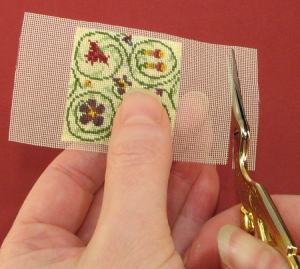
Making sure the design is centred, trim the stitched fabric to one and five eighths of an inch wide (4.3 cm). Then trim the height to two and seven eighths of an inch (7cm). Put the stitching aside for now.
NB: You do not need to use a fabric glue such as Fray Check with this kit.
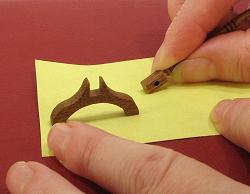
To complete the mahogany needlework stand, first lightly sand the mahogany pieces. Do a ‘dry-run’ assembly first, to make sure you know how all the pieces fit together, before using PVA glue.
Gently round off the base of each of the upright legs slightly to allow a good fit into the notch in each foot, as the notches that they will fit into have a slight curve at the corners.

Glue the two crossbars into the location holes in the upright legs.
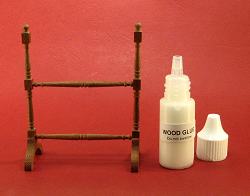
Glue the legs into the notch in the feet, and make sure that the frame is standing straight. Allow the glue to dry thoroughly.

Temporarily assemble the square frame that the stitching will fit into using the frame sides and the white wood poles. Test fit (using the brass pins to hold the frame in place) to make sure that the frame fits between the upright legs – sand off some of the pole length if necessary. DO NOT GLUE YET. Separate the frame side and pole part for now.

Now carefully wax polish the frame uprights, feet and cross bar structure, and the frame sides only (THAT IS, DO NOT WAX POLISH THE WHITE WOOD POLES).
Apply the wax polish with wire wool, and buff to a shine with a soft cloth. Two coats will give a good colour.
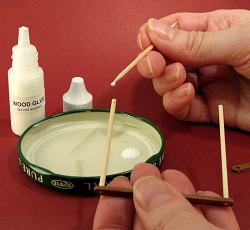
Re-assemble the square frame, once the sides have been wax polished, this time gluing the pieces in place. Wait until the glue has completely dried before attempting to mount the stitching in the frame.
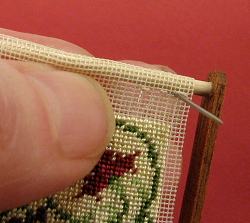
Take the piece of stitching, and, using a small sewing needle and cream sewing cotton (not supplied), wrap three eighths of an inch of the bare gauze around one of the white wood poles. Make sure that the design is centred on the frame. Line up the gauze so that you can stitch straight through both layers evenly along the length, as close to the pole as possible, using back stitch over two or three threads each time. Beginning about three eighths of an inch (1cm) from the edge of the gauze, and starting with a knot in the cotton, make two or three running stitches as you stitch out to the vertical side of the piece of gauze, then make more running stitches in the gaps that you left as you return to where you started (so that the line of stitches ends up looking like back stitch) – from then on, along the rest of the line, work back stitches – ending at the opposite edge in the same way (running stitches for two or three stitches in each direction, to hold the thread as you finish). Then secure your thread on the back.

Having attached the gauze to one pole, you then need to pull the gauze between the two poles taut (but do it gently!), wrapping the gauze around the second pole. Check that it is square in the frame. Then attach with a line of stitching as before.
Trim the spare silk gauze at the back of the square frame to about four fabric threads from your line of back stitching (being careful not to cut into the stitched side).
Attach the square frame between the upright legs with the brass pins, and your needlework stand is complete!

